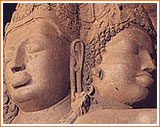Amaravati Tour
Amaravati lies on the right bank of River Krishna, 65 km from Vijayawada in the Amaravati state of Andhra Pradesh. It is famous for the ruins of a 2000-year-old Buddhist settlement and the great Buddhist stupa. Amravati is considered as one of the most sacred pilgrim center for the Buddhists.

Amaravati was the capital of the Satavahana dynasty, which ruled continuously for four centuries. Buddhism made its appearance in Amaravati influenced by the Kushanas of Mathura. On the Amravati Tours, you may visit the Great Stupa and a temple dedicated to Lord Amarwara.
The Great Stupa of Amravati is larger than the stupa at Sanchi erected at this place some 2000 years ago. The local refer to it as the Mahastupa and is also known as Deepaladinne or the Mound of Lamps. An envoy of Emperor Ashoka, who spread Buddhism in this region, laid the foundation of the Great Stupa at Amravati. The stupa is made of brick with a circular vedika and platforms protruding in four cardinal directions are 95 ft high.
The stupa is kept at the Government Museum in Chennai. Buddha is depicted in a human form on the circular panel subduing an elephant. It is based on a story of Devadatta, Buddha's cousin sending the elephant to attack the Buddha. A museum must not be missed while on tour of Amaravati. It houses a few remains from the stupa.
Buddhist AttractionsThe Amravati Stupa : Also known as the Mahachaitya Stupa, the Amravati Stupa happens to be the Amaravati largest stupa in the country. Today, only remains of the stupa can be seen, however, a number of tourists interested in the history of Buddhism make a visit to this site.

Ashokan Pillar : Excavations in Amravati have also unearthed the ruins of an Ashokan Pillar which is perhaps the first example of the Mauryan art in south India.
Amravati Museum : A small but interesting museum in Amravati display exhibits that range “3rd century BC to 12th century AD”. Some of the finest exhibits include statues of the Buddha with lotus symbols on his feet, curled hair and long ear lobes. Apart from this, there are also limestone sculptures of goddess Tara and bodhisattva Padmapani. A whole lot of other Buddhist sculptures that were excavated from here now adorn the Chennai Government Museum and the British Museum in London.
Other AttractionsThe Amareswara Temple: This temple is dedicated to Lord Shiva and houses a 15feet high white marble Shiva Lingam. On the four sides of the temple are huge gopurams in a typically Dravidian temple architectural style. As per a legend, the temple was initially a Buddhist one and was converted into a Hindu one only later. The walls of the Amaravati temple have a number of inscriptions that tell us about the various kings who held power in the area.
 Reaching Amaravati
Reaching Amaravati
By Air : Nagpur is the nearest airport, which is 155-km away from Amaravati.
By Rail : Nagpur is the terminus of the branch line of Central Railway on Mumbai-Kolkata main line. Tourists can access Amaravati from Nagpur. There are numerous trains every three hours between Hyderabad / Vijayawda & Guntur & Vice versa.
By Road : Regular buses connect Amaravati with the important towns and cities within the state Amaravati lies on the right bank of River Krishna, 65 km from Vijayawada in the state of Andhra Pradesh. It is famous for the ruins of a 2000-year-old Buddhist settlement and the great Buddhist stupa. Amravati is considered as one of the most sacred pilgrim center for the Buddhists.
How to reachBy Air : Aurangabad, 100 kms away is the nearest airport. Direct flights available from Delhi, Mumbai, Jaipur etc.
By Rail : Aurangabad is nearest railhead, Jalgaon, 59 km away, is good for catching swanky trains.
By Road : Well-maintained roads link Ajanta to Mumbai, good buses are also available. Ajanta- 100 kms, Bombay- 390 kms, Ellora- 32 kms, Nanded- 275 kms, Nasik- 224 kms, Pune- 232 kms.
Buddhist Tour Destinations








